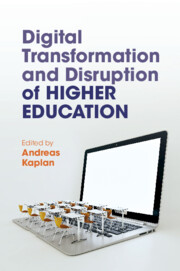Book contents
- Digital Transformation and Disruption of Higher Education
- Digital Transformation and Disruption of Higher Education
- Copyright page
- Contents
- Figures
- Tables
- Contributors
- Preface
- Chapter 1 Nothing Is Constant Except Change
- Part I (R)evolution of the Higher Education Sector
- Chapter 2 Higher Education’s Digitalisation
- Chapter 3 Online Learning
- Chapter 4 Social Exclusion and the Digital Divide
- Chapter 5 Internationalisation of Higher Education
- Chapter 6 Africa’s University Landscape
- Part II Changes in Teaching Formats
- Part III Changes in Teaching Content
- Part IV Networking and Social Activities
- Part V Certification and Diplomas
- Part VI Careers and Professionalisation
- Part VII Futuristic and Ultramodern Higher Education
- Part VIII Higher Education in Motion
- Editor’s Biography
- Index
- References
Chapter 5 - Internationalisation of Higher Education
The Case for Virtual Collaboration
from Part I - (R)evolution of the Higher Education Sector
Published online by Cambridge University Press: 09 June 2022
- Digital Transformation and Disruption of Higher Education
- Digital Transformation and Disruption of Higher Education
- Copyright page
- Contents
- Figures
- Tables
- Contributors
- Preface
- Chapter 1 Nothing Is Constant Except Change
- Part I (R)evolution of the Higher Education Sector
- Chapter 2 Higher Education’s Digitalisation
- Chapter 3 Online Learning
- Chapter 4 Social Exclusion and the Digital Divide
- Chapter 5 Internationalisation of Higher Education
- Chapter 6 Africa’s University Landscape
- Part II Changes in Teaching Formats
- Part III Changes in Teaching Content
- Part IV Networking and Social Activities
- Part V Certification and Diplomas
- Part VI Careers and Professionalisation
- Part VII Futuristic and Ultramodern Higher Education
- Part VIII Higher Education in Motion
- Editor’s Biography
- Index
- References
Summary
In recent years, an important goal of the German Academic Exchange Service (DAAD) has been to answer the question of how international collaboration and student mobility can be enhanced through digitalisation. The following chapter consists of a combination of desk research with insights from the work of the DAAD’s Digitalisation Section. It will provide both an overview of current trends and debates of the digitalisation of higher education as well as critical considerations for the future. The chapter will contribute to the debate on new dynamics of internationalisation of higher education through digitalisation before and during the recent COVID-19 pandemic. It will shed light on the flexibility of higher education systems in adapting to unexpected change. Furthermore, it will reflect on the likely impacts of the current crisis for the further development of higher education internationalisation with its opportunities, challenges and open questions.
Keywords
- Type
- Chapter
- Information
- Publisher: Cambridge University PressPrint publication year: 2022
References
- 1
- Cited by

